| Examination and Recording of Rock
Art |
South Deccan Prehistory Project Research Background New Museum Sub Projects Origins of Agriculture
in South India |
Rock art chronologies are still
poorly understood for the Southern Deccan, but it is clear that rock
art has been produced in the region from at least the Neolithic period
all the way up to the present day. Weathering
and destruction of rock surfaces has led to fading and loss of ancient
paintings and petroglyphs, but this region nonetheless possesses a
very rich rock art heritage that deserves more study than it has thus
far received (see for example photo at right).
Various rock art sites in Bellary district have been investigated
during the project, particularly in the Sanganakallu-Kupgal
heritage area. These consist of both rock painting and rock bruising
(petroglyph) sites. Rock paintings tend
to occur on granite, while bruisings are often found on dolerite. While dolerite bruisings are often very faded, it is nonetheless
likely that they have preserved better than rock paintings on granite
surfaces, many of which have no doubt been lost due to processes of
granite exfoliation.
In Sanganakallu-Kupgal, the dolerite trap that runs through the hill locally known as Hiregudda is associated along its length with various rock art sites. Particularly notable is the large rock art site at the top of the hill, where hundreds of individual motifs are preserved along a jagged dolerite cliff (see photo at right). Our identification of this site with the help of local informants was a 'rediscovery' of sorts since although this important site has been known since the 19th century, certain more recent expeditions appear to have had trouble locating it, and have reported it as destroyed. Its location has been misidentified on some maps. While some of the rock art at the top of Hiregudda is clearly more recent, much of it would appear to date to the prehistoric period. Comparison to published sources and rock art at nearby Neolithic settlement sites suggests that many of the petroglyphs date to the Neolithic period. Cattle motifs are the most common, and often consist of singular depictions of long-horned, humped back cattle of the type that are common in South India today. Cattle are also shown in pairs, usually facing each other, as well as atop tridents. Sometimes people are shown standing on top of cattle, or hunting/taming cattle. Humans are probably the second most common forms depicted. Often these bear erect phalluses, and some appear to be engaged in sexual activity. A more common motif is rows upon rows of so-called 'dancing' figures that are holding hands in long chains. Other, motifs include elephants, tigers, birds, wheeled carts, footprints and religious symbols. A unique discovery during the field season were the 'ringing rocks' at the top of Hiregudda. Amidst the petroglyphs at this site, there are also round, polished grooves that emit musical ringing tones when struck with granite stones, as demonstrated to us by Ramadas of Sanganakallu village (see figure below). Similar ringing rocks were observed by us at another dolerite petroglyph site we subsequently visited. It is interesting to speculate that these ringing rocks were in use during the Neolithic period, and that the production of bell-like ringing sounds was in some way associated with rock art production and/or viewing in prehistory. Many recent archaeological studies have emphasised the importance of senses other than the visual in understanding rock art, and it has been noted that sound was probably an important feature of rock art creation and, often, consumption. This and other aspects of the Hiregudda rock art, such as its ritual and landscape context are explored in a paper by Boivin (2004) in Antiquity. |
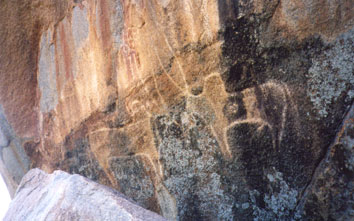 Neolithic
period petroglyphs at
Velpumadugu in Andhra Pradesh 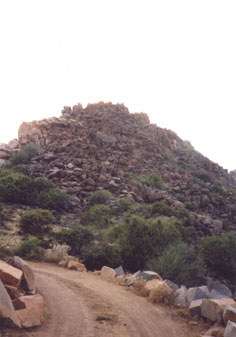 Rock art site at top of Hiregudda 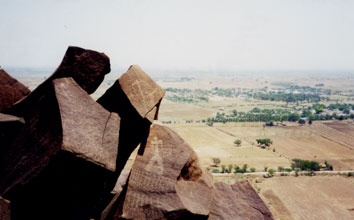 Petroglyphs depicting human figures at Hiregudda |
||
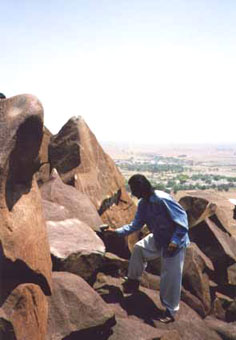 Ramdas and the 'ringing
rocks' at Hiregudda |
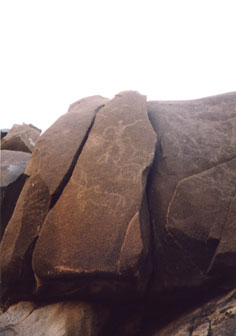 Rock art including bulls and human figure at Hiregudda |